PinotFile: 12.32 October 4, 2022
|
Joe Rochioli Jr., the Humble Patriarch of Russian River Valley Pinot Noir
Joe Rochioli Jr. was the quintessential dedicated Italian winegrower whom I greatly admired. I met with him on three occasions (2005, 2011, and 2015), usually in one of the rows of his historic West Block Pinot Noir vines, when he was very generous with his time. We did not discuss his wines, but rather his life story and the farming of wine grapes which was his passion. I wrote an extensive biography on him in 2020, www.princeofpinot.com/ article/2237/, referring to him as “no ordinary Joe,” not realizing until recently he had suffered a stroke later that year that eventually led to his demise at age 88 on August 18, 2022, nearly on my birthdate of August 19. My obituary of Joe Rochioli Jr. (referred to as “Joe”) follows. The history of the Rochioli family begins with Joe’s grandfather, born in Northern Italy and left at a very young age on a doorstep in town. The family that initially cared for him was extremely poor and eventually sent him to an orphanage. Since he had no sir name, he was given the sir name “Rochioli” (Ro-kee-o-lee) at the orphanage, a word in Italian that had no meaning. Joe’s father, Joe Rochioli Sr. was also born in Northern Italy. He immigrated to the United States in 1912, following in the footsteps of many notable Italian-American families that became legends in the Sonoma County winescape. Joe was born in Sebastopol in 1934. His family moved to the Wohler Ranch adjacent to the Russian River Valley in Healdsburg in 1938. Joe’s family leased land from the Walters family who owned the ranch and grew hops, grapes, prunes and vegetables. The Rochioli family was very poor but Joe Sr. was able to buy portions of the Wohler Ranch he had been leasing until he eventually owned 162 acres. Joe’s family only spoke Italian so when Joe entered school at a one-room schoolhouse two miles up the road from his home, he was ridiculed for his lack of English and his homemade lunches. Life was very hard with Joe working daily on his father’s farm after school in his formative years. Joe grew to be 6-foot-tall and weighed 180 pounds, and was very athletic, starring in football and baseball at Healdsburg High School although he had not played those sports growing up. After college at Cal Poly San Luis Obispo and a stint in the U.S. Army, he was a key player for the semi-pro baseball team, the Healdsburg Prune Packers. By the time Joe returned home after leaving the service in 1959, Joe Sr. had replaced 50 acres of grapevines that dated to the 1890s consisting mainly of a field blend which was popular with Italian winegrowers with French Colombard (high quality and sold to large wine companies like E.& J. Gallo) and Cabernet Sauvignon (a wrong choice for the region’s climate as it failed to ripen). Grapes provided little income so Joe Sr’s primary crop had been hops. When the hops business declined in 1953, Blue Lake string beans were planted and Joe Sr. became one of the largest string bean growers in California. Interplanting of string beans (two rows of string beans between two rows of grapevines) continued until the beans were all pulled out in 1963. Joe’s father turned over the wine grape growing to him but resisted Joe’s interest in planting grape varieties suitable for the Russian River Valley terroir. Varieties such as Pinot Noir produced less crop and did not attract money in those days so it was less profitable. However, Joe knew that the ranch land, which had seven feet of fertile soil over Yolo sandy loam and a compatible climate, was ideal for certain grape varieties. He finally talked his father into planting Sauvignon Blanc in 1959. Joe took budwood from a row of Sauvignon Blanc vines at UC Davis that he deemed best and planted 10 acres on the Rochioli property. The vines were so vigorous that he had to trellis them on a Double Geneva Curtain configuration. The original vines are still producing today and the wines from these vines have won more awards for Rochioli Vineyards & Winery than any other wine produced. The clone will forever remain a mystery as the sourced vines at UC Davis were pulled out. Joe begged his father to plant Pinot Noir. Joe was aware of the quality of French red Burgundy and had a hunch that the Pinot Noir grape would do well at the Rochioli ranch. After Joe Sr. died in 1968, Joe bulldozed the 8 acres of the Colombard and Cabernet Sauvignon vines and planted Pinot Noir. Many locals thought he was crazy but the local farm advisor was supportive.
Joe wanted to concentrate on French Burgundy varietals, specifically Pinot Noir. He believed the future of grape growing in the Russian River Valley was in varietal wines rather than bulk wine blends that were the norm of the 1960s.In neighboring Napa Valley in the 1960s, practically every maker of premium wines produced a varietally-labeled and often vintage-dated Pinot Noir, but good examples were rare and often underwhelming but to warm, misplaced vineyard sites and winemaking that was inappropriate for the Pinot Noir paradigm. By the early 1970s, with rare exception, California Pinot Noir was deemed unsuitable by many wineries as a stand-alone varietal and those wineries ceased production of Pinot Noir. Nevertheless, Joe was resolute in his vision.
Pinot Noir budwood was scarce at the time but Joe was able to locate a Frenchman in Napa who reluctantly gave him some “suitcase” budwood that was likely French Pommard. Joe planted 4 acres of East Block Pinot Noir in 1968, one of the earliest plantings of Pinot Noir in the Russian River Valley. (The first well-documented planting of Pinot Noir in the Russian River Valley was by Charles and Helen Bacigalupi, who, upon the advice of Sonoma County farm advisor Bob Sisson, planted Pinot Noir in 1964 at their Healdsburg home ranch using presumably Pommard budwood obtained from Karl Wente’s vineyard in Livermore.) In 1970, 4 acres of West Block Pinot Noir was planted using budwood from Karl Wente. Most likely, this was a form of UCD 4 Pommard. Chardonnay vines were first planted on the ranch in 1972. Joe’s first viable crop of Pinot Noir was in 1971 and was sent to a co-op crush facility in Windsor for E.& J. Gallo, the only buyer at the time. Joe recalled, “I was sick sending my beautiful Pinot Noir grapes from East Block and West Block to Gallo who then threw the grapes in with other varietals, mainly Zinfandel and Petite Sirah from Sonoma and the Napa and Central Valleys (“Gallo garbage”), to make his highly successful Hearty Burgundy. It wasn’t until later that Joe had acquired contracts for his grapes. In 1973, Davis Bynum, a San Francisco newspaperman, bought the 84-acre River Bend Ranch on Westside Road, converted an existing hop kiln into a winery and launched Davis Bynum Winery. He purchased all of Rochioli’s Pinot Noir from the 1973 vintage and put the name Rochioli on the bottle’s labels. The Davis Bynum Rochioli Pinot Noir was the first contemporary Pinot Noir wine from the region labeled as originating in the Russian River Valley. In 1976, Joe made 1,000 cases of Pinot Noir and Chardonnay at Davis Bynum under the Fenton Acres label. Beginning in 1979, he sold some West Block Pinot Noir to Williams Selyem who made it famous. Since 1997, when the winery was sold, Williams Selyem has only received Pinot Noir from newer and old plantings in the River Block. Gary Farrell, the winemaker at Davis Bynum, made 50 cases of 1982 Rochioli Pinot Noir from West Block and Allen Vineyard which launched his Gary Farrell label. That same year, he crafted 150 cases of Pinot Noir at Davis Bynum Winery using grapes sourced from Joe to launch the J. Rochioli Vineyards & Winery wine brand (label below). The 1983 and 1984 vintages of J. Rochioli Pinot Noir were also vinified by Gary Farrell at Davis Bynum winery.
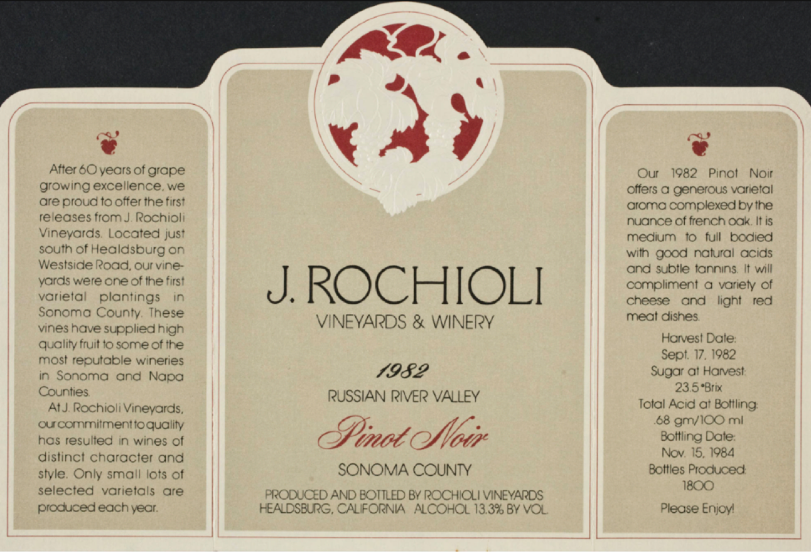 In 1982, Joe’s son, Tom, became disenchanted with his job in the banking business world and decided to join his father. He utilized his business acumen to build a 10,000-case winery that was constructed on the Rochioli ranch in time for the first crush at Rochioli in 1985. The J. Rochioli Vineyards & Winery brand name was suggested by Tom initially to imply a family operation. Tom made his first wines in 1985 at the new Rochioli winery with the supervision of Gary Farrell. He completed the 1986 Estate wines on his own and has been the only winemaker at Rochioli ever since. Tom had an intuitive sense of how the Rochioli fruit should be handled and achieved instant success. In addition to wine production, Tom has controlled every aspect of the winery business. He lives on the property in a house on the hill above the Rochioli estate that Joe built entirely himself over a two-year period. Tom became very involved with Joe in the vineyard management as well and has supervised the vineyard planting over the past twenty years. Joe (left) and Tom are pictured below.
 The demand for Rochioli fruit really took off when the 1985 Williams Selyem Rochioli Vineyard Russian River Valley Pinot Noir won a Double Gold Medal and the Sweepstakes Award at the 1987 California State Fair Competition, surpassing 2,316 other wines submitted by 416 wineries. The wine was sourced from the original West Block plantings (this was not evident on the label) and was the first vineyard-designated Pinot Noir produced by Williams Selyem. 295 cases of this wine were made and it sold for $16 a bottle! Further recognition came in the same year when the Wine Spectator named the 1985 J. Rochioli Vineyards & Winery’s first estate Pinot Noir the “Best Pinot Noir in America.” Joe was soon able to demand premium prices for his grapes. He continued to sell fruit mainly to Williams Selyem and Gary Farrell Vineyards & Winery (and Alysian Wines when Gary Farrell founded that label) and for years these two wineries were the only ones permitted to put “Rochioli Vineyard” on the label. Today, the permission has been extended to Miura, Ramey Wine Cellars and Terry Bering for his Castalia label. Terry has been at J. Rochioli Vineyards & Winery since 1990. and Cellar Master for the past 28 years. Currently, about 50% of grapes harvested at Rochioli and declassified bulk wine each year are sold to other wineries but not named as a source by the receiving winery. There are many other notable small prestigious producers of Pinot Noir in California who have begged for fruit but have had to settle for a place on a long waiting list. Cuttings from Rochioli vines are no longer sold or given away. Joe was the epitome of a hard-working farmer who had no interest in money. For most of his life, he rose at 4:00 am and worked 10 hours a day, 6 days a week. Joe performed almost all the equipment repairs required on his farm including welding. He crafted most of his own implements, rebuilt engines, restored plows and cultivators, and designed farming tools like cane cutters.
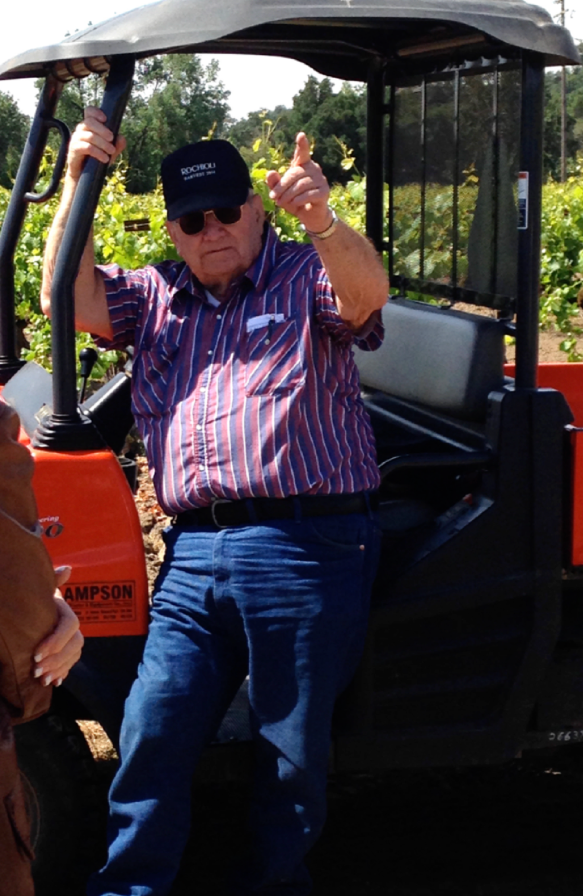 With time, Joe developed numerous physical problems caused by the years of hard labor and required at least ten surgeries including ones on his back, knees and shoulder. Throughout his life, he spurned vacations, but when I saw him in 2005, he was leaving for Hawaii with his extended family for a hard-earned rest. Joe is responsible for a number of important innovations in grape growing that originated from his acute intuition and common sense as well as a number of awards for his viticultural acumen:
(1) Joe knew early on the importance of limiting yields to improve the quality of the resultant wines. He found,
for example, that the Pommard vines in his vineyard could produce five or six tons per acre when young
but the ripened grapes lacked color and flavor. Keeping yields well under four tons per acre greatly
improved grape quality. Today, yields are often more like 1.5 tons per acre.
Joe was divorced in 1969 and married Vivienne Sioli, the girl he adored in high school (pictured below). Joe had two previous children, she had three, and between them, they have eleven grandchildren. In the Italian tradition, Joe and Vivienne hosted frequent family dinners on weekends with nearly forty family members in attendance. Joe preserved much of his history including his father’s horse saddles and horse carriage, a restored Model T truck, and his prized restored 1941 Chevrolet that he drove in college (pictured below).
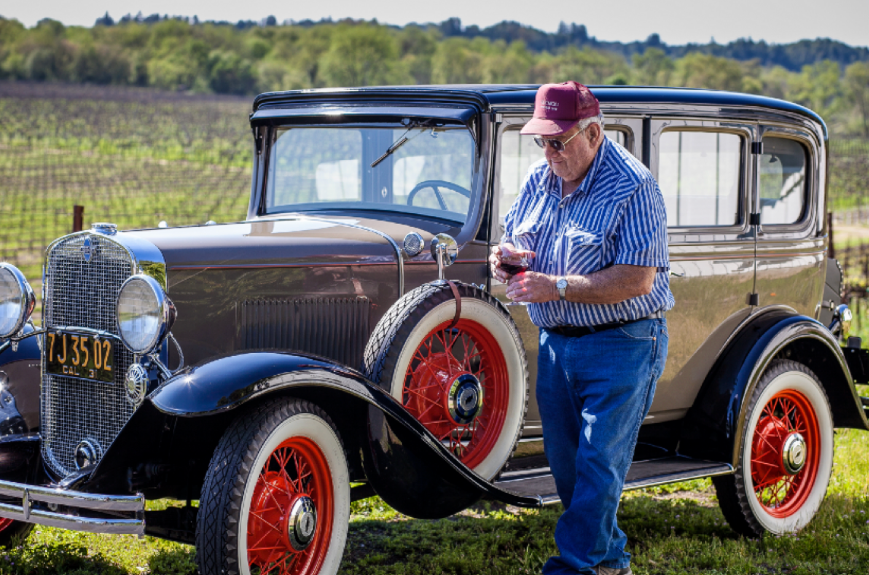 Joe was certainly no ordinary Joe and he leaves behind a history of superb wines that reflect his years of devotion to winegrowing. I have never met anyone like him and have never discovered another winegrower with such a remarkable story to tell. When asked how he produced such remarkably good wine grapes, Joe replied, “It’s the combination of soil, climate, clones, instinct, and farming practices. Joe’s legacy is best summarized in his own words: “My father taught me the ethic of hard work. You work hard to eat and put a roof over your head. I used to dream about living to be 65 and becoming a millionaire. I’ve ended up with a great winery and good friends, and I am proud of what I’ve accomplished as a shy, little Italian boy who spoke no English.” Joe’s funeral services were held on Wednesday, September 7, with full military honors and a big turnout.
J. Rochioli Vineyards & Winery: The Wines
An Estate Pinot Noir has been produced every year since 1982. It is a blend of most or all of the single-block vineyards except for Three Corner. The average annual production of the Estate Pinot Noir is targeted for 4,800 to 5,500 cases, but that number has not been reached since 2020. The 2022 vintage was about 25% lighter overall. Tom expects full production to return in 2024/2025. Tom told me the Estate Pinot Noir is put together once he creates the blends of Sweetwater, Little Hill and Big Hill. He blends various lots on the property and anything that does not quite make the cut is bulked out. Since the red blotch-infected vines have been removed, all the lots have been perfectly acceptable. The sizable production of the Estate Pinot Noir and its wide distribution by fine wine marketer Terlato Wines International mean it is sold by many retail sources in the US such as Total Wine & More and is also offered for sale on the winery’s website and at the winery’s tasting room. The Estate blends of Pinot Noir, Chardonnay, and Sauvignon Blanc are bottled under the Rochioli name, while the single-block vineyard-designated Pinot Noirs and Chardonnays are labeled as J. Rochioli Vineyards & Winery. The classy labels have remained essentially the same through the years. Beginning with the 2018 vintage, the back label of the Estate wines stated “Single Vineyard Blend” to more accurately reflect the wines as blends of several single-block vineyards. The labels for Rochioli Estate Pinot Noir and J. Rochioli West Block Pinot Noir:
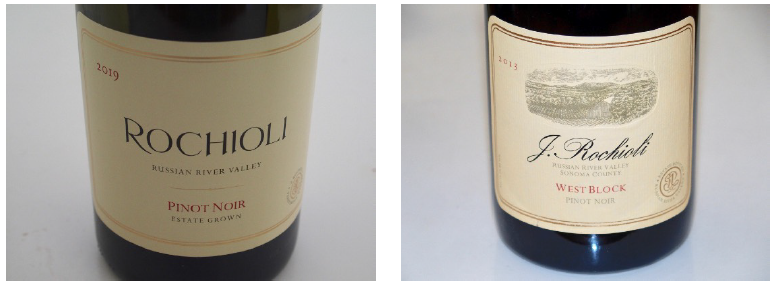 There is a story behind Rochioli’s block-designated Pinot Noirs.Tom had visited Domaine Romanée-Conti (DRC) in Burgundy (Joe never went to Burgundy) in 1990 and was struck by the differences in the wines from the winery’s seven climats. Tom has remarked, “Here are these blocks of vines together in a small area on a slope that looks fairly uniform, yet the wine from each plot is unique and different.” Tom had noted differences in barrels from different blocks on the Rochioli estate despite the fact that a majority of the vine material originated from West Block cuttings, the cultivation was identical throughout the estate, and the vinification was the same. He realized that like DRC, Rochioli vineyards had distinct blocks that produced wines reflecting differences in terroir due to subtle disparities in soil and microclimate. In 1992, the first of the block designates debuted with the West Block and Three Corner Block Pinot Noirs. East Block was released separately in 1993 1994, and then yearly from 1997 to 2008. Little Hill Block and River Block debuted in 1999, and the Sweetwater Vineyard Block was first offered in 2007. The five original single-block Pinot Noirs: East Block, West Block, Three Corner, Little Hill and River Block were first offered together in 1999. A map of the 140 planted acres at Rochioli Vineyard detailing the blocks is available on the winery’s website. The vinification of Rochioli Pinot Noir involves primarily whole berry fermentation with proprietary yeasts in stainless steel open-top tanks. Up to 20% whole cluster may be included depending on the vintage, vineyard block, and ripeness of the stems. This adds a spice cabinet flavor to the finished wines. Hand punch-downs of the cap are employed. The wines are sent to barrel without extended maceration. Aging extends for 15 months in about 30% new French oak for the Estate wines and 40%-50% new French oak for the single block wines. The wines are held in bottles until the early part of the subsequent year in the case of the Estate Pinot Noir wines and the later part of the subsequent year for the block-designated Pinot Noir wines. The Rochioli Pinot Noirs are not bashful wines, instead offering a ripe, rich, succulent fruit core with cola and spice features. That said, the wines are never overblown, too big or oaky and retain an appealing freshness. Many wine writers have raved about the Pinot Noir wines, calling them, “A liquid portrait of the Russian River Valley.” Regarding age ability, the best window for the Estate Pinot Noir is 3 to 5 years and for the block-designated Pinot Noirs 6 to 10 years. That said, there are no strict guidelines. Tom simply says, “As the vines get older, and as I get older, the wines get better.” The vineyard block-designated Pinot Noir and Chardonnay wines are allocated through a mailing list at www.rochioliwinery.com. There is quite a wait to receive an allocation and those wishing to receive an allotment need to purchase the Estate wines regularly or risk falling off the list. The demand for the block-designated wines far outstrip the approximate 3,000 cases a year of production. The winery could easily sell twice the amount of wine production but the emphasis is on improving quality not expanding sales. The winery is in an enviable position since the lack of need for promotion relieves the winery of those expenses and allows it to concentrate on farming and wine production. The 2020 Rochioli Estate Russian River Valley Pinot Noir (currently sold on the winery’s website) and Chardonnay have been released. Don’t ignore the winery’s outstanding Estate Sauvignon Blanc!
2019 Rochioli Estate Russian River Valley Pinot Noir 14.5% alc., 3,198 cases, $60-$90 depending on source. Released January 2020. 53% Little Hill, 15% Big Hill, 14% West Block, 6% East Block, and 12% Sweetwater. Hand punch downs, aged 15 months in 3-year and 4-year air-dried Francois Fréres French oak barrels, 30% new. · Moderately light garnet color in the glass. Enticing aromas of cherry vanilla, strawberry, cola, and spice lead to a mid-weight styled palate with flavors of Bing cherry, spice, edible flower, and cola framed by suede tannins. Easygoing and forward, picking up interest and intensity when re-tasted the following day from a previously opened bottle. Still captivating two days after opening. Score: 94
2020 Rochioli Estate Russian River Valley Chardonnay 14.5% alc., 1,740 cases, $60-$62. 59% River Block, 31% Mid 40, and 10% Little Hill. Whole cluster pressed to barrel with no skin contact. 100% malolactic fermentation. · Mild golden yellow color in the glass. Richly aromatic with scents of lemon, warm nuts and oak spice with a hint of slate. Slightly creamy on the palate, offering citrus-inspired goodness with notes of pear and judicious oak in the background. Clean acidity with a touch of warmth on the finish. Score: 91
For all reviews of Rochioli Pinot Noirs, visit www.princeofpinot.com/article/2238/. One final interesting side note. In July 2005 I hosted a vertical tasting of 1992-2002 J. Rochioli West Block Pinot Noirs. It was a spirited evening marked by celestial Pinot Noir attended by members of my wine club, Le Grand Crew. The event was attended by a number of luminaries including Art “Deep” Fries, Steve “Slide Rule Dember, Mike “Cash & Carry” Cohen, Ed “Big Boy” Buckley, John “Dookey” Maggiano, and Rene “Master Somm” Chazottes. These were vinous treasures that made a lasting impression on the attendees. All the wines had aged beautifully with no sign of oxidation. The wines offered fresh fruit aromas, an impressive mid-palate attack of luscious and deeply concentrated Pinot Noir fruit, soft textures, appealing charm, and impressive balance. Tasting notes of all block designated Rochioli Pinot Noirs through 2006 are also included at www.princeopinot.com/article/1125/.
Gary Farrell Vineyards & Winery: Inseparably Linked to J. Rochioli Vineyards & Winery since 1982
Some historians consider Gary Farrell the father of Russian River Valley Pinot Noir because he was one of the first Pinot Noir winemakers to rise to prominence at the beginning of the Pinot Noir revolution in the region in the 1980s. Largely self-taught, but also educated through UC Davis winemaking extension courses, Farrell enhanced his winemaking skills during the mid-1970s working in the cellars of Tom Dehlinger, Robert Stemmler, and Davis Bynum. He was employed initially at Davis Bynum as a handyman and cellar worker. He was soon befriended by Davis Bynum’s son, Hampton, who hired him as a winemaker and Farrell made his first Pinot Noir at Davis Bynum in 1978. Farrell continued there as the winemaker until 2000. Farrell started his own eponymous label in 1982, releasing a 50-case blend of Rochioli West Block and Allen Vineyard fruit. He traded grapes for his winemaking expertise for his inaugural release. He was to act as a consultant in the planning and construction of the Rochioli Winery which finished construction in 1985. Farrell would say that he got Rochioli fruit before the word got out. The close relationship between the two wineries continues to this day (40 years) with Gary Farrell receiving grapes annually from Rochioli Vineyard, including grapes from the oldest blocks and the Allen Vineyard which was planted and managed by Joe. In 2000, Farrell, backed by investor and vintner Bill Hambrecht, moved into a magnificent $5 million winery designed by Farrell located on a ridge at the southern end of Westside Road, a 20-minute drive from the town of Healdsburg. Production rose to 12.000 to 14,000 cases annually, over half of which were Pinot Noir. He would plant the 25-acre estate Starr Ridge Vineyard in the Russian River Valley and another 15 acres in the Green Valley of Russian River Valley appellation. Farrell sold his label and Westside Road Winery in 2004 and the winery was subsequently bought by the Vincraft Group. He left the Gary Farrell Winery in 2006 to return to his roots as a small artisan producer, founding a new label, Alysian Wines, but in 2013 left Alysian Wines to concentrate on his hobby of buying and selling collector cars. I met Gary on one occasion to taste his Alysian wines and found him reserved and soft-spoken but very charming and friendly. He is not one to tout his wines or go into detail about their vinification. As Gerald Asher, writing in Gourmet in 1996, noted, “For a man who produces such structured and elegant wines, Farrell is surprisingly vague when it comes to talking about them.” Farrell did tell Asher the following. “In winemaking, there’s always an element of intuition and that’s especially true with Pinot Noir. I’m often asked by an assistant to explain why I do something, and I’m hard put to answer. With Pinot Noir, some special sensitivity, a sixth sense, is at work. You must start with good fruit and there’s not much of it. The site must be right, the clones must be right, and the vineyard practices must be right.” Asher summarized his impression after tasting Farrell’s Pinot Noir wines, saying, “All his wines are restrained. I got the impression that Farrell took from the grapes exactly what he needed - and no more.” I began drinking Farrell’s Pinot Noirs with the 1986 vintage and his 1987 Russian River Valley Pinot Noir was one of my early epiphanic Pinot Noir experiences. I was not alone in realizing the superb quality of Farrell’s wines. Syndicated wine columnist Jerry Mead said, “Gary is one of the most talented winemakers in California, and one of America’s best when it comes to the very difficult grape Pinot Noir.” Gary Farrell Vineyards & Winery has been in the very capable winemaking hands of Theresa Heredia since 2012. She has had the title of Director of Winemaking since the spring of 2021. Gary left behind many winemaking protocols that Theresa has used to emulate the “Farrell house style” that emphasizes elegance and balance and a bright acidic spine while putting her own imprint on the Farrell wines. The winery has offered two very different wines based on Rochioli fruit: the Rochioli-Allen Vineyards Russian River Valley Pinot Noir is lighter weighted, more acid-driven, and features redder fruits. The Rochioli Vineyard Pinot Noir is bolder, more intensely fruited, featuring darker fruits, and a spectacularly long finish. Theresa related to me her recollections of Joe: “Joe Rochioli was one of the sweetest men I’ve known. I can picture him now with his eyes gleaming and a big smile on his face. He loved to sit and talk about the old days, sharing stories about playing baseball with the local Prune Packers team as well as his Cal Poly days. He could go on for hours telling his stories. As far as I know, he never fully retired from day-to-day duties until he had a stroke at the end of 2020. Every year since I’ve been the winemaker at Gary Farrell. from 2012 until 2019, Joe and his wife Vivienne attended our annual grower appreciation dinner at the winery. Joe told us it was one of his favorite events because it took place after the harvest had settled down and before the crazy Holiday season. He really enjoyed exchanging stories with all of the other growers in attendance. He enjoyed the wines from Rochioli but also the wines from Gary Farrell’s other vineyard sources. Sadly, since 2020 we have not been able to host him at the grower dinner because of the pandemic. This year will be our first in-person grower dinner since 2019, and we were planning to honor Joe. Instead, we will honor him at the event this November by sharing memories of him with everyone in attendance. Rest in peace Joe. Your legacy will live on forever through our beautiful memories of your stories.” Visit the winery’s website for more information and to purchase wines at www.garyfarrellwinery.com. Some wines are library only or available only to wine club members. If you inquire, mention this article.
2017 Gary Farrell Rochioli-Allen Vineyards Russian River Valley Pinot Noir 13.3% alc., pH 3.33, TA 0.70, 369 case, $80. Released May 2020. The grapes for this wine come from two vineyards: Rochioli vineyard and Allen Vineyard, located on opposite sides of Westside Road and both farmed by the Rochioli family. Predominantly Pommard selection planted in 1974 and 1996 from Allen Vineyard and Pommard from the Rochioli Vineyard, Primarily de-stemmed fruit with some whole cluster. 4-7 day cold soak, 7-10 day postfermentation extended maceration. Aged on the primary lees for 15 months in French oak barrels, 40% new. $80. · Moderately light garnet color in the glass. Soaring aromas of fresh cherry, strawberry, balsam, and baking spices. Light to moderate weighted style with black cherry, cola, and a hint of oak flavors driven by bright acidity. Gentle tannins with a long, quenching finish. Score: 93
2019 Gary Farrell Rochioli-Allen Vineyards Russian River Valley Pinot Noir 14.2% alc., $80. · Moderately light garnet color in the glass. Aromas of red cherry, oak spice and vanilla, and red rose petal. Inviting flavors of cherry, strawberry and raspberry framed by bright acidity and the slightest tannin. Satisfying, with a noticeably long finish. Score: 93
2018 Gary Farrell Rochioli Vineyard Russian River Valley Pinot Noir 13.9% alc., pH 3.55, TA 0.76, 538 cases, $80. Released September 2021. 80% of the fruit was gently de-stemmed and 20% was added to the fermentation tank as whole clusters. 5-7 day cold soak 10-15 day extended maceration. Aged 15 months in French oak barrels, 40% new. · Moderate garnet color in the glass. A knockout nose with deep aromas of dark cherry, olallieberry, spice, pencil lead and toast. Fuller-bodied in style, with a richly flavored dark cherry core. Slightly earthy with a shadow of oak. A silky, Pinot-typical mouthfeel brought smiles. Outrageously long, fruitsoaked finish. Still superb when tasted two days later from a previously opened bottle. Score: 95
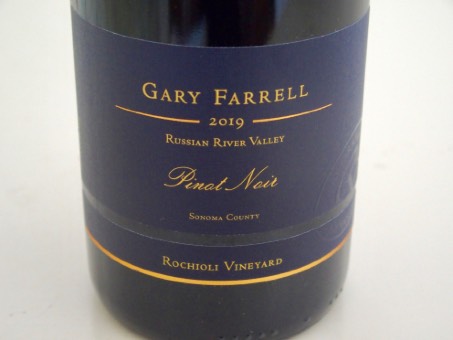 2019 Gary Farrell Rochioli Vineyard Russian River Valley Pinot Noir 14.1% alc., pH 3.28, TA 0.71, 426 cases, $85. Released September 2022. Member exclusive. This wine brings together three blocks on the property, including those planted in 1974, 1995, and 2000 where some of the vines come from cuttings taken from the original mother block plantings dating to 1968. Harvest Brix 23.5º. 82% of the fruit de-stemmed and 18% added to the top of the fermenting tank as whole clusters. 7-day cold soak, 12 days of extended maceration following fermentation. Aged 15 months in French oak puncheons, 40% new. · Moderate garnet color in the glass. This nose is typical of what attracts me to Pinot Noir: aromas of dark Bing cherry, spice, dried cranberry, and pipe smoke. Well-endowed in a midweight plus style, with a flood of black cherry and raspberry goodness saturating the mid-palate. Almost meaty, yet polished, with seamless incorporation of oak and an extremely long and lip-smacking finish. A revelation and a great tribute to Joe Rochioli. Score: 98
More recently released Gary Farrell Pinot Noir:
2019 Gary Farrell Martaella Vineyard Russian River Valley Pinot Noir 13.7% alc. pH 3.30, TA 0.68, 601 cases, $70. Released in September 2022. A blend of Calera, Mt Eden and Swan selections. The fruit was primarily de-stemmed. 5-7 day cold soak and 7-10 day post-fermentation extended maceration. Aged on the primary lees for 15 months in French oak puncheons, 40% new. · Moderate garnet color in the glass. The nose opens over time to reveal appealing aromas of black cherry, blackberry, baking spice, and chai tea. Mid-weight plus in richness, offering flavors of purple and black berries and black tea. Complimentary tannins and acidity with some finishing generosity. Noticeably better when sampled two days later from a previously opened bottle. Score: 93
2019 Gary Farrell Toboni Vineyard Russian River Valley Pinot Noir 14.3% alc., pH 3.33, TA 0.69, 629 cases, $60. Released September 2022. The Toboni Oakwild Ranch is located on the Santa Rosa Plain, an area blessed with morning fog and sunny, warm afternoons that heighten the intensity of the fruit flavors. Planted in 2001 to clones 115, 667, 777, and Pommard. The fruit was predominantly de-stemmed with a small percentage added later as whole clusters. 4-7 day cold soak and 7-10 day post-fermentation extended maceration. Aged 10 months in French oak barrels, 40% new. · Moderate garnet color in the glass. Reserved aromas of ripe strawberry, blackest cherry and earthy flora. Brooding flavors of purple and black berries in a mid-weight plus style. The tannins are rather tame, a shadow of oak plies the background, and the finish delivers length with a hint of alcoholic warmth. Score: 92
Wine Briefs
Gabilan Mountains is California’s Newest AVA This new AVA, California’s 147th, is large at 30 miles long and covers a mountain range in two counties. The vineyard that prompted the AVA application is Coastview Vineyard which sells most of its grapes to Big Basin Vineyards. Big Basin will be the only winery to use the new AVA on a label since Chalone Vineyard and Calera, both located in the Gabilan Mountains AVA, have no plans to use the new appellation on their labels (Calera will continue with Mt Harlan. A to Z Wineworks and Rex Hill Sold to Ste. Michelle Wine Estates Ste. Michelle Estates, owned by New York-based Sycamore Partners, already owns Erath and with this recent acquisition, will have a total annual production in Oregon of about 700,000 cases according to Tim Fish reporting at www.winespectator.com. A to Z is said to offer wines of good quality at fair prices but I have tasted very few of the winery’s Pinot Noir offerings. The 2021 Oregon Wine Industry Report The annual Oregon Vineyard and Winery Report released by the Oregon Wine Board indicates the Oregon wine industry withstood the pandemic challenges of labor shortages, extreme heat and wildfire events, and more during 2020 and recovery was evident in 2021. Total wine grape production increased 53% over 2020 to a record 114,677 tons, exceeding both 2018 and 2019. In 2021, total harvested acreage was up 17%, total planted acreage was up 6%, the number of Oregon wineries increased by 6%, and DTC sales increased by 24%. Total sales almost reached 5.3 million cases worth $844 million. About 26% of grapes harvested in Oregon were not crushed in Oregon, suggesting a trend of Oregon tonnage sold out of state. Pinot Noir accounted for 60% of all planted acreage in 2021 and 61% of wine-grape production. It would seem that Oregon Pinot Noir is immune from the state of the economy. Heat and Wine Grapes According to an article at www.tastingtable.com, heat continues to be one of the biggest threats to wine grapes, which prefer cooler temperatures than table grapes. Wine and climate expert Dr Greg Jones states that some grape varieties like Pinot Noir cannot withstand more than a 3.6- degree average Fahrenheit change over time. 2 degrees has been the average growing season temperature increase since 1970 in the US meaning that some regions have exceeded the heat requirements for Pinot Noir. The article concludes, “If the prediction models are correct, we have 28 years left to enjoy the popular wines we drink today and maybe we will be drinking wines made primarily from hybrid and indigenous grapes.” More on heat. California has heatwave records set in the first week of September. Temperatures rose to 115ºF in the Russian River Valley and 117ºF in Mendocino County. The surface (skin) temperature of grapes can increase to 140ºF. Nighttime temperatures are also significantly higher than usual. Wine grapes that are exposed to these high temperatures for a few days will shrivel and become raisins. UC Davis viticulture specialist Kaan Kultural reported at www.wine-searcher.com, “We are going to have to change the varieties we grow. I don’t believe we should plant any more Burgundian varieties, rather plant Rhone varieties, and 20 years from now, plant Spanish and southern Greek varieties. Want to Aim for Drinking Wine in Moderation? A new, small study published in the journal Addiction found that a simple habit can help reduce the amount consumed on a regular basis. A control group continued to drink from 750ml bottles while a second group opted for 375ml bottles and drank out of 290mm glasses instead of 350mm glasses. Those who purchased wine in smaller bottles drank one fewer glass of wine than those from larger bottles. More significantly, those who drank from the smaller glasses imbibed 6.5% less wine or the equivalent of 1.7 fewer glasses over 14 days. Alcohol Warning Label Update Needed According to Researchers An article published by two researchers recently in the New England Journal of Medicine believe that new alcohol warning labels should be designed and adopted that warn about the risk of cancer. However, only a few cancers have been proven to have an increased risk in drinkers, most notably in heavy drinkers. The subject of the association between alcohol consumption and cancer risk seems to me to be far too complicated to summarize on a small wine label. Research recently published in the journal JAMA found that increased alcohol consumption was associated with higher risks for alcohol-related and all cancers, whereas sustained levels of moderate drinking, quitting, and reduced drinking was associated with lower risks of alcohol-related and all cancers. Alcohol in Moderation Digest The September edition has an analysis of a paper on alcohol consumption and health outcomes among 70-year-olds in Sweden by The International Scientific Forum on Alcohol Research. The paper emphasizes how a large number of factors may modify the association between the amount of alcohol consumed and measures of health and disease. The Forum raised questions about the traditional belief that the elderly should consume markedly less alcohol than younger subjects, suggesting that the limitations placed on subjects related solely to their age may often not be appropriate. Other reports' conclusions: *Increasing alcohol intake significantly during mid-to-late adulthood raised colorectal cancer risk among men while reducing lowered risk. *Abstinence from alcohol appears to be associated with an increased risk of all-cause dementia. Among current drinkers, there appears to be no consistent evidence to suggest that the amount of alcohol consumed in later life is associated with dementia risk. Vineyards of West Sonoma Coast AVA The West Sonoma Coast Vintners have made this map available. Visit www.westsonomacoast.com. The new West Sonoma Coast AVA is made up primarily of steep, rugged mountainous terrain within seven miles of the Pacific Ocean coastline and consists of approximately 50 vineyards planted primarily to Pinot Noir, Chardonnay and Syrah. From north to south, the AVA comprises Annapolis, Fort Ross-Seaview AVA, and Freestone-Occidental.
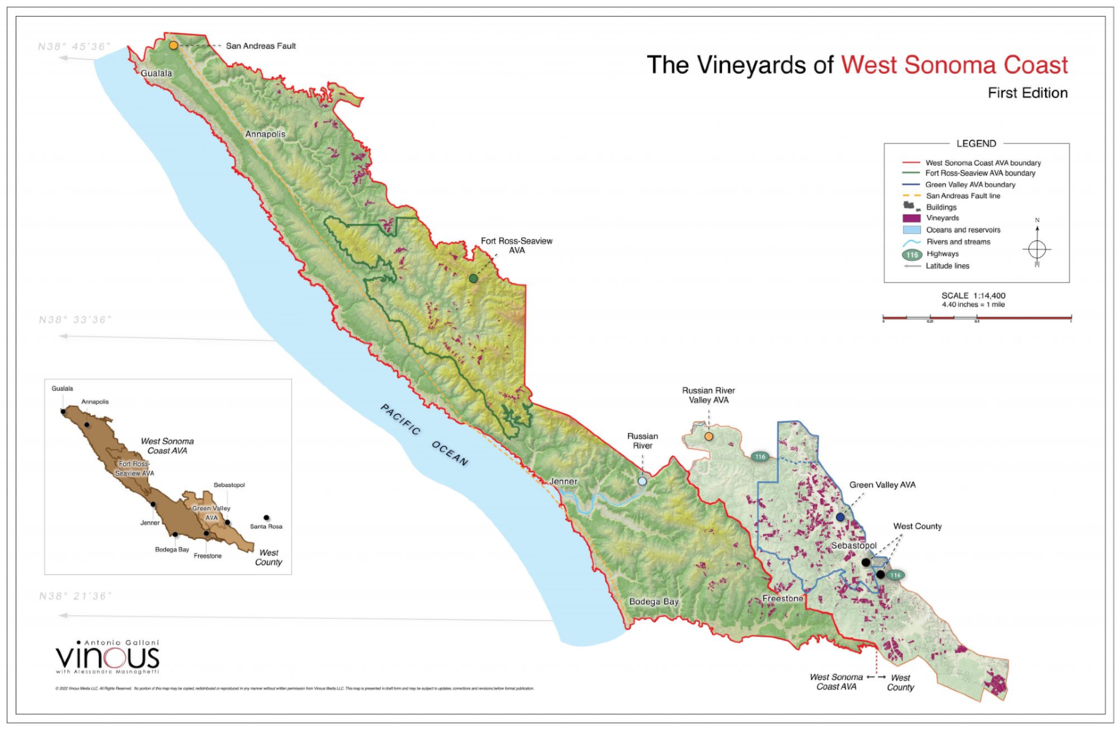 Boomers Show Largest Percentage Decline in Wine Purchases
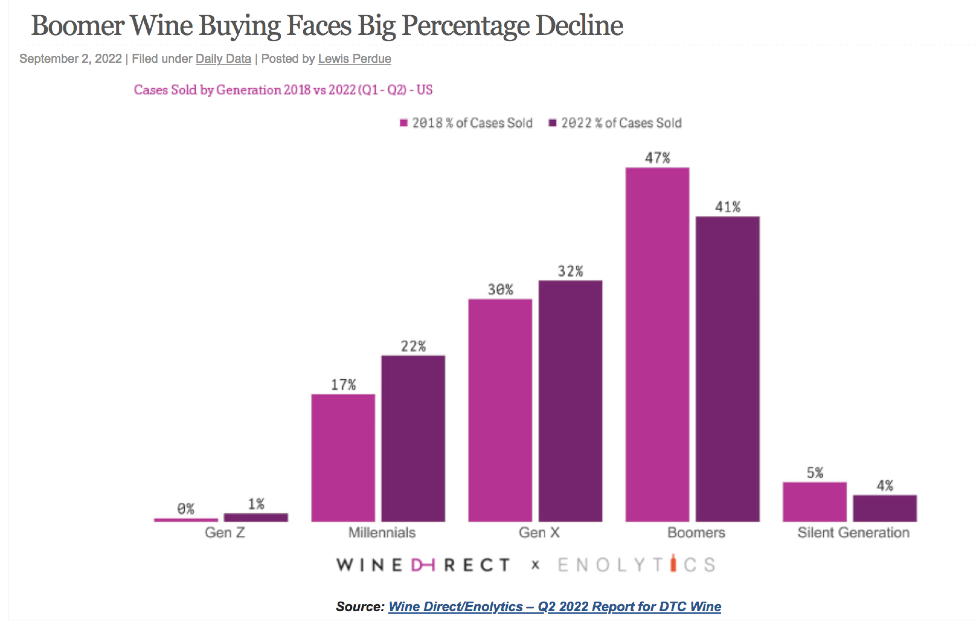 Palm Springs Pinot Noir Festival The Third Annual Palm Springs “A Passion 4 Pinot” Pinot Noir The Festival will be held January 27-28, 2023 at the Westin Gold Resort and Spa in Rancho Mirage. The Grand Tasting is Saturday, January 28 ($125-$175), the Sun, Wind & Wine Santa Lucia Highlands Luncheon is on Friday, January 27 ($125-$175) and includes participating wineries Beau Marchais, Bernardus, Clarice Wine Company, Mansfield Dunne, McIntyre, Miner, Morgan, Roar, Siduri, Tolosa, Walt, and Wrath. Two dinners are on Friday, January 27: The Russian River Valley 40th Anniversary Dinner ($150-$200) and A Hidden Gem: The Anderson Valley 40th Anniversary Dinner ($150-$200). Tickets on sale now at www.palmspringspinotfest.com. Promo code for PinotFile readers is PRINCE. The code takes $25 off the price of an Early Entry ticket to the Saturday Grand Tasting and $15 off the price of the Friday Santa Lucia Highlands Luncheon. Pinot On The River Registration is open for the 19th Pinot On The River taking place on Saturday, October 8, 2022. Two years have passed since the last event. The new location is in downtown Santa Rosa on Old Courthouse Square. 40 small production artisanal wineries will be pouring. All proceeds benefit Sonoma County Pride. Tickets and more information are available at www.pinotfestival.com.
 The Eyrie Vineyards Nominated for 2022 Wine Enthusiast Wine Star Award for American Winery of Year The Eyrie Vineyards has built on its legacy as the first commercial Pinot Noir vineyard in the Willamette Valley and has become a leader in regenerative and sustainable farming. this historic winery’s tasting room has reopened by reservation on Fridays and Saturdays. Visit eyrievineyards.com.
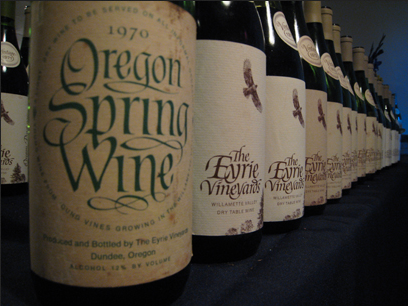 Revered Oregon Winemaker Lynn Penner-Ash RetiresAfter 41 harvests, she looks back on a career that included her first job in Oregon at Rex Hill Winery, before founding Penner-Ash with her spouse in 1998. The Penner-Ash brand was sold to Jackson Family Wines in 2016 and Lynn has gradually handed the winemaking over to Kate Ayres who will continue the Penner-Ash style.
 Russell Rainey Remembered. I have written glowing reports on the Pinot Noir wines that come out of the Evesham Wood Vineyard & Winery both when founder Rainey was making the wines and when Erin Nuccio took over as his successor in 2010. Evesham Wood was established by Russell and his spouse Mary in 1986 in the Eola-Amity Hills just outside of Salem, Oregon. Rainey was a Burgundian at heart in his approach to viticulture and winemaking. He was at the forefront of certain practices during the fledgling years of Oregon’s wine business such as dry farming his estate Le Puits Sec Vineyard and not filtering his wines before bottling, Evesham Wood wines always represented very good quality at reasonable prices and were easy to recommend to others. Vintage 21 in Willamette Valley The warmest overall vintage in Willamette Valley history followed the smoke-compromised 2020 vintage. Temperatures in the Valley in 2021 reached 119 degrees and the 90 degree heat persisted for several days. That said, the heat occurred early in the growing season so the grapes were not badly affected. After the heat wave, harvest proceeded normally. Early reports indicate that the Pinot Noir wines from the 2021 vintage have good balance and intensity. Most of the ultra-premium Pinot Noirs will not be released until late 2022 and spring of 2023 so time will tell. One thing is for sure: yields were lower than average so the availability of top wines will be limited. The Science of Smelling The October 2022 issue of Smithsonian Magazine at www.smitsonianmag.com features an article titled, “Sniffing Out the Science of Smelling.” The information presented has relevance to wine tasting and scoring. Research has shown that about 30 percent of an individual’s receptor arsenal functions differently than a neighbor’s so any conversation starting with “Do you smell that?” often goes nowhere. For example, “A substance like androsterone - a musk found in human sweat, truffles and elsewhere - can smell like sandalwood or urine or nothing at all, depending on the nature of the smellier.” It is commonly stated that the consumer should follow wine critics whose preferences align with theirs and a commonality in the perception of smells may have something to do with this. It is well known that females are more sensitive to smells yet the field of wine criticism is dominated by males. Does this mean women wine consumers should only follow women wine critics? Obsessive Wine Collecting I recently read an interesting medical study that helped me understand obsessive wine collecting. This new study has confirmed the widespread belief that links both obsessive wine collecting and Republicanism to a wide range of medical disorders of the lower intestinal tract and anus. The hoarding impulse which can result in the obsessive stacking of case upon case upon case of wine in one’s cellar and massing of far more bottles than one could ever possibly consume in a lifetime shares a common pathological etiology with the most virulent strains of right-wing Republicanism. It is the belief of researchers that both of these behaviors arise from developmental milestones that were never completely resolved. It is suspected that obsessive wine collectors did not learn how to share and play well with others in preschool. Equally likely, their potty training was thoroughly screwed up by their parents. These sufferers, many of which are successful men, are now nothing more than fully grownup big babies who have never really made the successful transition out of diapers. (the source of this humor long forgotten). Allocation is the Most Feared Word to Pinot Noir Consumers When a winery refers to allotment as allocation in reference to periodic wine offerings, it causes the hairs to stick up on my neck. The winery uses the word, of course, to imply exclusivity and hard to get. Sometimes you receive an allocation and you check it early the same day and some of the most desirable wines are “sold out.” For me, allocation translates as “ I won’t get want I want and what I do get will cost me a lot of money.” With inflation at a high level currently, maybe the even more depressing words seen in an offering are “Buy your full allotment.” This implies you are rich and particularly worthy. In my formative Pinot Noir years, wineries let you just order what you wanted. There was a day not too long ago when I could order as much Gary Farrell and Rochioli Pinot Noir as I could afford. But Pinot Noir has gotten a big head, and triple-digit prices are now common. A newer winery with no track record from the West Sonoma Coast is offering 3 bottles (you must buy 3 bottles) of their latest Pinot Noir with a fancy French name packed in a wooden case for $1,000. Who the hell needs a Bordeaux-like wooden box and who wants to pay tax and shipping on that box and 3 bottles? It would seem these days that $80 is about average for an ultra-premium domestic Pinot Noir of quality pedigree. That seductive mistress is quickly becoming too expensive for the younger wine consumer (see chart above). While Boomers have always opened their wallets and said, “Pinot Please,” the Millennials are more likely to use their Apple cards to buy $15 Sauvignon Blanc from New Zealand. I doubt many Millennials even know the definition of allocation, or if they do, scoff at it. I am afraid the bloom is coming off the rose as domestic Pinot Noir prices follow the lead of red Burgundy. Sadly, mistress Pinot is becoming allocated only to the well-off. The current demographics of wine purchases related to household income reflect this:
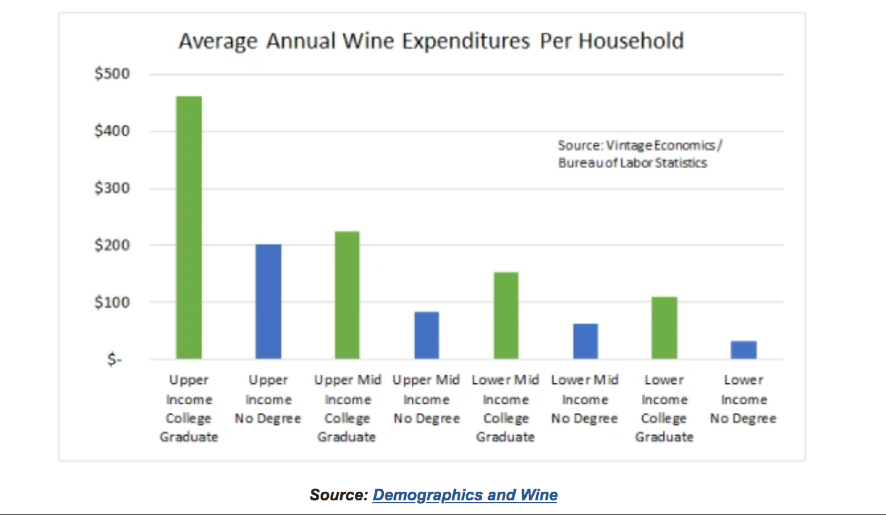 Added Note October 6: Joseph Phelps is offering two super-premium Pinot Noirs from the 2018 vintage called Proem No. 1 and Proem No. 2 sourced from their Freestone Estate. Are you sitting down? $225 per bottle. |